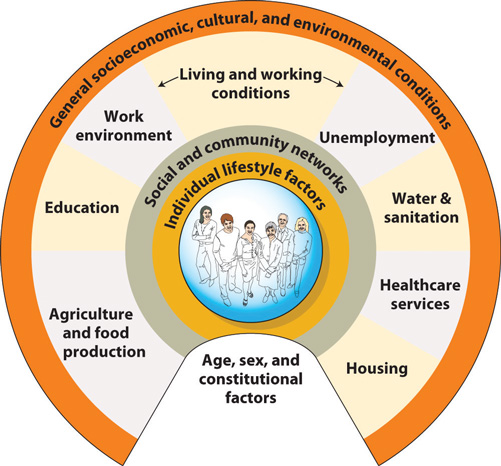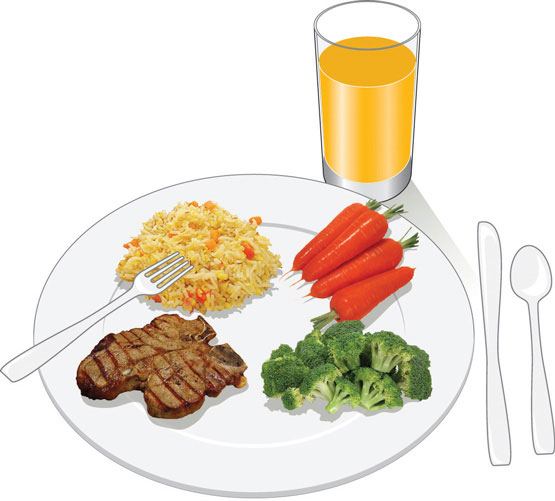This is “National Goals for Nutrition and Health: Healthy People 2020”, section 2.4 from the book An Introduction to Nutrition (v. 1.0). For details on it (including licensing), click here.
For more information on the source of this book, or why it is available for free, please see the project's home page. You can browse or download additional books there. To download a .zip file containing this book to use offline, simply click here.
2.4 National Goals for Nutrition and Health: Healthy People 2020
Learning Objectives
- State the Healthy People 2020 nutrition- and weight-status goals.
- List three related objectives for the Healthy People 2020 program.
The Healthy People 2020 program, launched in 2010, is a ten-year national program instituted by the US government with objectives aimed toward improving the health of all Americans. Similar to the 2010 Dietary Guidelines, it has been established to promote longer lives free of preventable disease, disability, injury, and premature death. With a revived intent on identifying, measuring, tracking, and reducing health disparities through a “determinants of health approach,” Healthy People 2020 will strive to create the social and physical environments that promote good health for all and to promote quality of life, healthy development, and healthy behaviors across all life stages. This means that the understanding of what makes and keeps people healthy is consistently refined. The determinants of health approachThese are the conditions reflective of the circumstances in which people are born, live, work, and age. It assesses the conditions that shape circumstances such as money, power, and resources at the local, national and global levels. reflects the evidence from outside factors that greatly affect the health of individuals.US Department of Health and Human Services. “About Healthy People.” Last updated March 29, 2012. http://www.healthypeople.gov/2020/about/default.aspx It takes into consideration the circumstances in which people are born, live, work, and age. It also reflects the conditions that shape their circumstances such as money, power, and resources at the local, national, and global levels. Social determinants of health are primarily accountable for the lack of fair health opportunities and the unjust differences in health status that exist within and between countries.World Health Organization. “Social Determinants of Health.” © 2012. http://www.who.int/social_determinants/en/.
Helping People Make Healthy Choices
It is not just ourselves, the food industry, and federal government that shape our choices of food and physical activity, but also our sex, genetics, disabilities, income, religion, culture, education, lifestyle, age, and environment. All of these factors must be addressed by organizations and individuals that seek to make changes in dietary habits. The socioeconomic model incorporates all of these factors and is used by health-promoting organizations, such as the USDA and the HHS to determine multiple avenues through which to promote healthy eating patterns, to increase levels of physical activity, and to reduce the risk of chronic disease for all Americans. Lower economic prosperity influences diet specifically by lowering food quality, decreasing food choices, and decreasing access to enough food. As a result of the recent financial crisis in America the number of people who struggle to have enough to eat is rising and approaching fifty million. In response to these recent numbers, USDA Secretary Tom Vilsack said, “These numbers are a wake-up call…for us to get very serious about food security and hunger, about nutrition and food safety in this country.”Amy Goldstein, “Hunger a Growing Problem in America, USDA Reports,” Washington Post, 17 November 2009. http://www.washingtonpost.com/wp-dyn/content/article/2009/11/16/AR2009111601598.html.

The socioeconomic model helps organizations and the government to plan and promote effective healthy-eating programs tailored to specific populations.
© Networkgraphics
Goals for Nutrition and Weight Status
While Healthy People 2020 has many goals and objectives, we are going to focus on the two goals for nutrition and weight status. They are to promote health and reduce the risk of developing chronic diseases by encouraging Americans to consume healthful diets and to achieve and maintain healthy body weights. Nutrition criteria are reflective of a solid scientific foundation for health and weight management. Emphasis is on modifying individual behavior patterns and habits, and having policies and environments that will support these behaviors in various settings, such as schools and local community-based organizations.

One of the ways that Healthy People 2020 strives to promote good health and nutrition is by bringing together multiple agencies and groups dedicated to achieving the Healthy People 2020 nationwide objectives.
© Shutterstock
Healthy People 2020 has defined their mission as:

Consuming nutrient-dense foods and limiting portion sizes of food will contribute to weight management. Avoiding excessive amounts of anything allows room for many food types in the diet.
© Dreamstime
- Identify nationwide health improvement priorities
- Increase public awareness and understanding of the determinants of health, disease, and disability, and the opportunities for progress
- Provide measurable objectives and goals that are applicable at the national, state, and local levels
- Engage multiple sectors to take actions to strengthen policies and improve practices that are driven by the best knowledge
- Identify critical research, evaluation, and data-collection needs
Healthy People 2020 has set key recommendations as follows:
- Consume a variety of nutrient-dense foods within and across the food groups, especially whole grains, fruits, vegetables, low-fat or fat-free milk or milk products, and lean meats and other protein sources
- Limit the intake of saturated fat and trans fats, cholesterol, added sugars, sodium (salt), and alcohol
- Limit caloric intake to meet caloric needsUS Department of Health and Human Services. “Nutrition and Weight Status.” HealthyPeople.gov. Last updated May 1, 2012. http://healthypeople.gov/2020/topicsobjectives2020/overview.aspx?topicid=29
Tools for Change
If you wait many hours between meals, there is a good chance you will overeat. To refrain from overeating try consuming small meals at frequent intervals throughout the day as opposed to two or three large meals. Eat until you are satisfied, not until you feel “stuffed.” Eating slowly and savoring your food allows you to both enjoy what you eat and have time to realize that you are full before you get overfull. Your stomach is about the size of your fist but it expands if you eat excessive amounts of food at one sitting. Eating smaller meals will diminish the size of your appetite over time so you will feel satisfied with smaller amounts of food.
Benefits of Following the Healthy People 2020 Goals
Nutrition and weight status are important to children’s growth and development. In addition, healthy eating habits will decrease risks for developing chronic health conditions such as obesity, malnutrition, anemia, cardiovascular disease, high blood pressure, dyslipidemia (poor lipid profiles), Type 2 diabetes, osteoporosis, dental disease, constipation, diverticular disease, and certain types of cancer.National Digestive Disease Information Clearinghouse, a service of National Institute of Diabetes and Digestive and Kidney Diseases, National Institutes of Health. “Am I at Risk for Type 2 Diabetes?” NIH Publication No. 09-4805 (November 2008). Last updated December 6, 2011. http://diabetes.niddk.nih.gov/dm/pubs/riskfortype2/.

Following the 2010 Dietary Guidelines will promote nutrition, weight loss, and weight maintenance as well as the reduction of chronic disease.
© Networkgraphics
Meeting the recommended intake for energy needs by adopting a balanced eating regimen as promoted by the USDA’s My Food Plate tool will assist people in losing and maintaining weight and in improving overall health.
Objectives Related to the Healthy People 2020 Goals
Seven out of every ten deaths in the United States are caused by chronic diseases, such as heart disease, cancer, and diabetes, and three-quarters of the country’s health spending goes toward the cost of treating these diseases. Helping people lose weight, maintain a healthy weight, and prevent chronic disease by improving dietary habits requires providing education about food and nutrition, assuring access to healthier food options, and promoting the desire and ability to become physically active. Some of the Healthy People 2020 program’s related objectives are discussed below.
- Improve health, fitness, and quality of life through daily physical activity. The Healthy People 2020 objectives for physical activity are based on the 2008 Physical Activity Guidelines for Americans, and reflect the strong scientific evidence supporting the benefits of physical activity. More than 80 percent of the current US population, from youth to adults, is not meeting these guidelines. Healthy People 2020 highlights the way that one’s level of physical activity is affected by environmental factors such as the availability of safe sidewalks, bike lanes, trails, and parks. It also highlights the legislative policies that improve access to facilities that promote physical activity. Understanding that personal, social, economic, and environmental barriers to physical activity all have a part in determining a population’s physical activity level, is an important part of being able to provide interventions that foster physical activity. Consistent physical activity is necessary for preventing chronic disease, improving bone health, decreasing body fat, and preventing an early death.
Video 2.3
Active versus Sedentary Lifestyles
(click to see video)This video provides a short overview of leading an active life versus a sedentary life.
- Increase the quality, availability, and effectiveness of educational and community-based programs designed to prevent disease and injury, improve health, and enhance quality of life. Healthy eating is a learned behavior. By increasing the number of community-based programs (schools, workplace, health-care facilities, local community groups) that offer guidance for healthy eating and lifestyle choices, people of all ages will learn good eating habits and will gain access to good food choices to help improve their diet and overall health.
- Improve the development, health, safety, and well-being of adolescents and young adults. Adolescents (ten to nineteen years of age) and young adults (twenty to twenty-four years of age) constitute 21 percent of the population of the United States. The financial burdens of preventable health problems and associated long-term costs of chronic diseases in this demographic group have the potential to be vast, and will be the result of attitudes and behaviors initiated during adolescence. For example, the annual adult health-related financial burden of cigarette smoking, which usually starts by age eighteen, is $193 billion.Adhikari, B. et al. “Smoking-Attributable Mortality, Years of Potential Life Lost, and Productivity Losses—United States, 2000–2004.” MMWR CDC Surveill Summ 57, no. 45 (November 14, 2008): 1226–8. http://www.cdc.gov/mmwr/preview/mmwrhtml/mm5745a3.htm.

Healthy children will lead to a healthy adult population with less disease, lower healthcare costs, and increased longevity.
© Shutterstock
- Reduce the consumption of calories from SoFAS in the population aged two years and older. A diet high in SoFAS contributes to excessive weight gain and poor health. Added sugars provide no nutritional value to foods. Excessive fat and sugar intake promotes tooth decay, obesity, Type 2 diabetes, unhealthy cholesterol levels, and heart disease. Being overweight increases susceptibility for developing high blood pressure, diabetes, cardiovascular diseases, and certain types of cancer. The evidence is clear that many chronic diseases are linked to unhealthy dietary patterns. Excessive consumption of SoFAS, in combination with the lack of plant-based foods, may contribute to higher rates of developing chronic diseases.
For more information on Healthy People 2020 and its related objectives for nutrition and weight status, please visit the website http://www.healthypeople.gov/2020.
Key Takeaways
- Healthy People 2020 is a health initiative with a ten-year objective of helping Americans improve health and well-being, and to live long, healthy lives. Among its many objectives are to promote health and reduce the risk of developing chronic diseases by encouraging Americans to consume healthful diets and to achieve and maintain healthy body weights.
- The goals of Healthy People 2020 are founded upon a determinants of health approach, which means they are reflective of the circumstances in which people are born, live, and work, as well as the conditions that shape their circumstances such as money, power, and resources at the local, national, and global levels. Diet patterns are influenced by genetics, environment, and cultural values. All of these things must be considered to provide the optimal approach to improving the health of the American population.
- Decreasing caloric intake and increasing physical activity are important strategies in achieving the goals of the Healthy People 2020 program.
Discussion Starters
-
Think of fun ways to increase physical activity in your life. Watch the video below for ideas.
How to Avoid a Sedentary Lifestyle
-
Review some of the Healthy People 2020 nutrition and physical activity program objectives. What objectives would you like to see enacted in your community? Why is this important to you?




